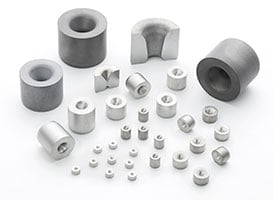
DuraNib™ Carbide Nibs
DuraNib carbide nibs are a revolutionary type of cemented carbide blank designed for non-ferrous wire drawing applications. The innovative carbide grade expands Hyperion's comprehensive portfolio of wire drawing solutions and is the first cobalt-free cemented carbide formulation in the market proven for wire drawing. Its phenomenal hardness stability at high temperatures of service and outstanding resistance to galling makes DuraNib unique.
DuraNib offers several benefits when drawing non-ferrous wire. It has a significantly lower friction coefficient than regular tungsten carbide grades, resulting in excellent resistance to material adhesion (galling). In applications with temperatures above 600ºC, regular carbide grades significantly drop hardness while DuraNib maintains stability. DuraNib also exhibits great corrosion resistance when in contact with acidic metals, making it an ideal choice for processes where the workpiece may be involved in challenging environments. Finally, DuraNib has a great balance of properties, maintaining a high toughness and wear resistance.
Product Groups
Hyperion Code: DuraNib™
Wire Material: Aluminum wire
Description: Cobalt-free cemented carbide drawing nibs (blanks).

Hyperion Code: DuraNib™
Wire Material: Aluminum wire
Description: Cobalt-free cemented carbide drawing nibs (blanks).

DuraNib™ Applications
DuraNib carbide blanks are especially useful in applications where galling is a significant challenge in wire drawing. Galling, a form of wear caused by adhesion between sliding surfaces, can lead to premature wear and scratching of the wire. DuraNib exhibits minimum wear and provides exceptional wire surface finish because of its galling resistance. Thanks to these properties, DuraNib is a perfect choice for drawing non-ferrous materials such as aluminum or copper high-voltage conductors, titanium for medical applications, and conforming copper with other applications.
Along with its revolutionary productivity advantages, DuraNib is also an innovative leader in environmental sustainability. DuraNib does not contain cobalt as its metallic binder like most cemented carbides, which promotes a healthy and safe environment for those using the product.
Hyperion Materials & Technologies offers DuraNib carbide nib blanks in numerous standard geometries, such as DIN, JIS, ISO, and R-Series. The offering can be as-sintered, OD ground, or cased.
FAQs about DuraNib™ Carbide Nibs
DuraNib carbide nib blanks are a revolutionary cobalt-free cemented carbide grade designed for drawing non-ferrous wire made of materials such as aluminum, copper, or titanium.
DuraNib carbide nibs provide several benefits for drawing wire. First, its cobalt-free properties offer a healthy and safe environment when utilizing the product. It also provides several benefits that allow it to draw aluminum, copper, or titanium compared to other carbide products such as:
-
Lower friction coefficient
-
Prevents material adhesion
-
Maintains stable hardness at extremely high temperatures
-
Great corrosion resistance to acidic metals
-
High toughness and wear resistance
DuraNib carbide nibs are used for drawing non-ferrous wires such as aluminum or copper high-voltage conductors, titanium for medical applications, and conforming copper between other applications.
DuraNib carbide nib blanks are available in various standard geometries such as ISO, JIS, and DIN or are tailor-made to your design. However, despite no size limitation, Hyperion recommends using DuraNib in die blanks with bore sizes above 3 mm, generally using dry lubricants during the drawing process.
DuraNib carbide nibs can prevent wire die galling. For example, when drawing aluminum high-voltage conductors, the metal is easily affected by galling due to its cold-welding of soft metals placed under high friction pressures. Due to its very low wear properties, DuraNib carbide blanks can reduce surface cohesion and resist galling buildup between the wire and the die within high temperatures.
As a cemented carbide grade, wire drawing blanks and dies made of DuraNib can be finished with the same process parameters as conventional carbides. Toolmakers can use the same diamond compounds and machinery used for conventional carbide grades.